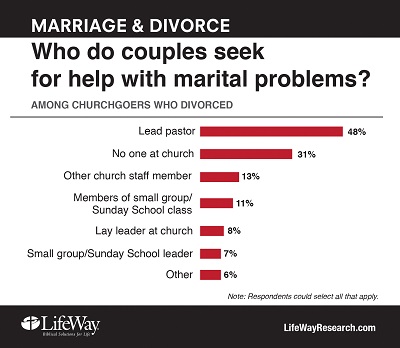By Bob Allen
 While 94 percent of Protestant pastors believe their churches are safe places to talk about marital difficulties, fewer than half of churchgoers who divorced in the past five years discussed their marriage problems with the lead pastor, according to new findings by LifeWay Research.
While 94 percent of Protestant pastors believe their churches are safe places to talk about marital difficulties, fewer than half of churchgoers who divorced in the past five years discussed their marriage problems with the lead pastor, according to new findings by LifeWay Research.
High percentages of both churchgoers who divorced (77 percent) and those in healthy marriages (79 percent) agreed in principle that their church is a safe place to talk about marital problems. While their own marriages were failing, however, just 48 percent of the divorced sought counsel from their pastor.
Smaller percentages spoke to someone else, such as a staff member or Sunday school class, but 31 percent told no one at church about their marital problems.
Scott McConnell, LifeWay Research vice president, called that a troubling sign of church culture, because if couples are unwilling to discuss marital struggles at church, they don’t get the help they need.
“If churches are dogmatic and not realistic about relationships, then those who have trouble in their marriage are never going to tell anybody,” McConnell said. “That’s a wake-up call to the church.”
Half of divorced churchgoers said their church prayed for them after their separation, and 43 percent said their church supported them. Eleven percent said their church made them feel uncomfortable after they separated, and a third (34 percent) said a friendship from church has grown more strained after their divorce.
Four in 10 (42 percent) received professional counseling outside the church prior to their divorce.
Four in 10 churches have had at least one couple divorce or separate in the last year, and in 73 percent of those cases at least one person stoped attending church. About one in 10 churches (9 percent) have experienced a small group or Sunday school class disband as a result of divorce.
The survey commissioned by Focus on the Family polled Protestant pastors, churchgoing Americans in healthy marriages, and churchgoing Americans who divorced in the past five years. The survey sample of 1,000 claimed 95 percent confidence that the sampling error does not exceed plus or minus 3.2 percent.
